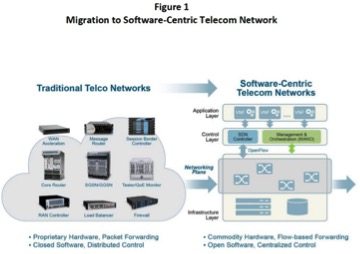Advanced SDN and NFV platforms are central to mobile operator migration plans, offering lower costs and better performance
The increasing commoditization of network bandwidth along with competitive pressure from over-the-top providers is causing leading communication service providers to question and recognize the immediate need to improve their network operations. In addition, CSPs’ networks must be able to support new applications such as secure hybrid wide area networks for business customers, data analytics, high quality video, bandwidth on demand and the “internet of things.” Shifting from the traditional central office to a virtualized data center environment provides new opportunities for CSPs to meet these application demands, while gaining the economies of scale, security, scalability and lower operational costs already achieved by hyperscale cloud operators.
These hyperscale data centers use software-defined networking and network functions virtualization technologies. NFV leverages information technology, including virtualization, standard servers and open software to fundamentally change the way networks are built and operated. SDN, on the other hand, enables the separation of the control plane and the data plane to facilitate improved management and application innovation.
With its ability to automate application deployment, SDN provides a powerful complement to NFV’s ability to maximize utilization of hardware resources. Together, NFV and SDN accelerate cloud network innovation while significantly reducing the costs of building and operating networks.
Hyperscale data center requirements
When transitioning from the central office of the past to the virtualized data center of today, certain requirements must be met.
Scalability
The network must be able to automatically adapt to workload fluctuations with no impact to performance.
High availability
The network must deliver service availability without interruption.
Predictable control and distribution of traffic flows
CSPs must have the ability to dynamically classify and distribute traffic flows to the appropriate virtualized functions.
Multivendor management and orchestration
CSPs must use open source software, allowing multiple vendor solutions to interoperate and enabling a multidomain view of network health.

Open for business
Open standards and open source software are critical for the multivendor management and orchestration of NFV/SDN. Leading CSPs as well as networking and IT suppliers all are contributing to standards development and open source code with the goals of enabling faster time-to-service, a better subscriber experience and innovative third-party applications (e.g. virtual network functions).
There are a number of important initiatives underway. The Open Network Operating System, driven by ON.Lab, is a carrier-grade SDN NOS, which provides scalability, high availability, high performance and abstractions to make it simple to create applications and services. The platform is based on a proven architecture and has quickly matured to be feature-rich and production-ready. The ONOS community has grown to include more than 50 partners including AT&T, Verizon Communications, China Unicom, NTT and SK Telecom.
The Central Office Re-architected as a Datacenter recently became an independent open source project, with Google, Radisys and Samsung as new partners. CORD presents a revolutionary architecture that exploits the best of SDN, NFV and cloud technologies. It delivers an integrated platform with merchant silicon, white box switches, ONOS, OpenStack, Docker and XOS.
NFV and SDN pave the way
CSPs are moving toward SDN- and NFV-based architectures to rapidly deliver new services, improve customer satisfaction and reduce costs. NFV provides the software to virtualize network functions and run them as data center applications. SDN provides centralized control and management to operate distributed software-based networks. Together, NFV and SDN can revolutionize the design, deployment and operations of telecom networks – thus providing significant benefits in terms of time to service, capital expense and operational efficiency.
When planning their migration to the hyperscale NFVi environment, CSPs should consider high-performance platforms based on commodity hardware and open source software – adapted to telecom requirements – to run their innovative NFV and SDN applications. These platforms must be able to elastically scale up to thousands of virtualized functions with high reliability and security, classify and distribute heterogeneous traffic flows arriving from the network to the virtualized functions, and support multivendor management and orchestration.
CSPs also should look to vendors that provide a partnership for their evolution to NFVi environment and that support a wide range of applications and services. These CSPs will benefit from partners with strong systems integration and professional service skill sets to preintegrate, test and validate high-performance NFV platforms.
The migration path is clear. Now is the time for CSPs to take the first step.

Bryan Sawowski serves as VP of FlowEngine and DCEngine, bringing more than 20 years of telecom expertise to the role, including extensive experience working directly with communications service providers. Prior to Radisys, Sawowski was most recently VP of professional and advanced services for Sonus Networks, where he spent a decade in a variety of leadership positions, including sales, marketing and business and product development. He holds a Global Master of Arts in International Relations from Tufts University and a Bachelor of Arts in Mathematics from Boston College.
Editor’s Note: In an attempt to broaden our interaction with our readers we have created this Reader Forum for those with something meaningful to say to the wireless industry. We want to keep this as open as possible, but we maintain some editorial control to keep it free of commercials or attacks. Please send along submissions for this section to our editors at: dmeyer@rcrwireless.com.

